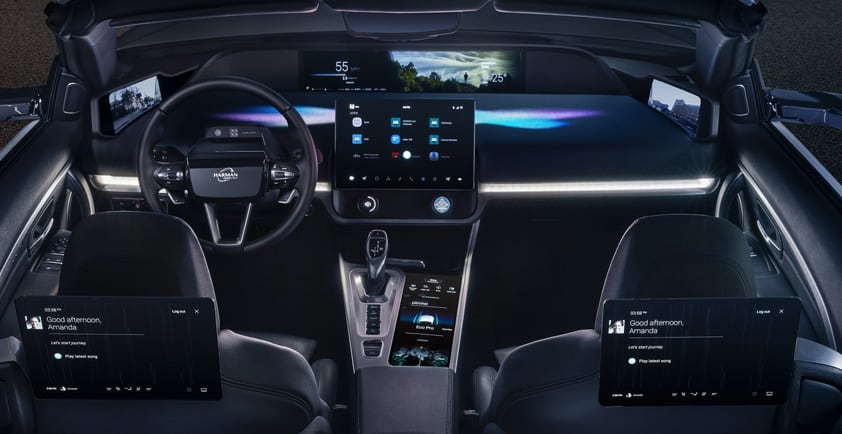

MMWAVE 5G TCU IS ENABLING NEW IN-VEHICLE EXPERIENCES
From safety solutions that alert you of hazards while driving, to technology that allows passengers to view concerts from the comfort of their vehicles, a whole new wave of connected vehicle technologies is right around the corner. However, to enjoy various experiences on the move, vehicles must be equipped with telematics control units (TCUs) to allow faster data communication in the vehicle.
As the advancement of TCU technology makes an increasing number of in-vehicle activities possible, the communications technology that allows large volumes of data to travel at faster speeds is becoming increasingly important. Samsung Electronics introduced the world’s first 5G-ready TCU in 2019, and now it has turned its attention to 5G mmWave. When it comes to providing large quantities of road information to the driver in real-time and implementing connected-car services, the ability of 5G mmWave to facilitate the transmission of large volumes of data at rapid speeds is crucial.
Ultra-high Speed, Ultra-low Latency and Ultra-connectivity for Connected Vehicles
TCUs capable of tapping into 5G can provide information on the road to the driver while also utilizing rapid internet speeds to enable high quality content to be displayed. While it was working on developing the 5G TCU, Samsung came to the conclusion that 5G mmWave, which reduces data transfer latency to a minimum and is capable of covering a lot of vehicles at once, would be necessary to enable prompt communication between vehicles, pedestrians and infrastructure.
5G mmWave offers 100MHz to 1GHz of bandwidth, which is more than 10 times wider than the 5 to 100MHz of bandwidth currently offered by most wireless communication solutions operating on sub-6GHz spectrum. Samsung, having realized the unlimited possibilities of mmWave spectrum from the outset, has worked on making 5G a reality for more than ten years, starting with the frontier research regarding high-speed digital transmissions at ultra-high frequencies in 2009.
Based on such efforts, the wider bandwidth offered by mmWave allows large amounts of data to be transmitted more quickly, enabling users to seamlessly make use of real-time road information and vehicle-to-vehicle communication. However, the establishment of this technology required differentiated antenna positioning and a TCU design that would ensure stable communication due to high penetration losses, high propagation losses and the ease with which signals are blocked by obstacles.
Mass Data Transmission Achieved with mmWave and Beamforming Technology
In order to efficiently transmit, receive and utilize 5G mmWave, Samsung utilizes array antenna beamforming technology. Beamforming technology allows antenna beams to be concentrated in a certain direction and transmitted powerfully. This technology minimizes unwanted interference, increases transmission coverage and enables data to be both sent and received at ultra-high speeds through more stable connections and faster transmission, even when the vehicle is moving. To achieve this, Samsung underwent a lot of trial and error and extensive testing before producing a feasible circuit design and, eventually, establishing the mmWave 5G TCU.


Automotive mmWave 5G TCU developed by Samsung Electronics
Compact Macro, Samsung’s mmWave base station, has 1,024 antenna elements and supports sharp and precise beamforming. The 5G Compact Macro offers seamless connectivity to high-speed cars driving at 200 km/h, successfully delivering the full benefits of 5G to users.
Beamforming has been optimized through field testing in which the technology was implemented in real vehicles. An optimized heat sink structure was implemented by conducting current energy consumption and heat radiation tests to make sure the TCU would still work in extremely hot or cold temperatures.
The New Experiences Enabled by the mmWave 5G TCU
5G mmWave array antenna beamforming technology is expected to deliver a solution with great potential. When the Automotive mmWave 5G TCU for vehicles is commercialized, rapid and stable communications will enable a whole new world of improved in-vehicle services. What’s more, users will be able to enjoy both safe and entertaining driving, in addition to enhanced V2X (Vehicle to Everything) services.
One of the most anticipated vehicle functions that is expected to be brought closer to realization due to the establishment of the mmWave 5G TCU is complete autonomous driving. This is because real-time communication with no delay in data transmission allows you to be aware of road conditions in advance and prepare for unexpected situations. In addition, the technology will enable use cases such as vehicle platooning and the remote driving of unmanned vehicles. When a driver is driving their vehicle themselves, a quick risk warning service and high-definition road images transmitted with ultra-low delay will further assist in making driving safer.
And opportunities for passengers to access entertainment will be more abundant as well. Traveling will no longer have to feel tedious when mmWave services such as UHD 8K video streaming are made available from all seats in buses and taxis. But the entertainment options won’t be limited to video streaming, with this technology also allowing viewers to access content such as games, live concerts and events, and other brand new multimedia services that utilize VR (virtual reality) and AR (augmented reality). We look forward to watching 5G TCU technology contribute to transforming the in-vehicle experience for users.













